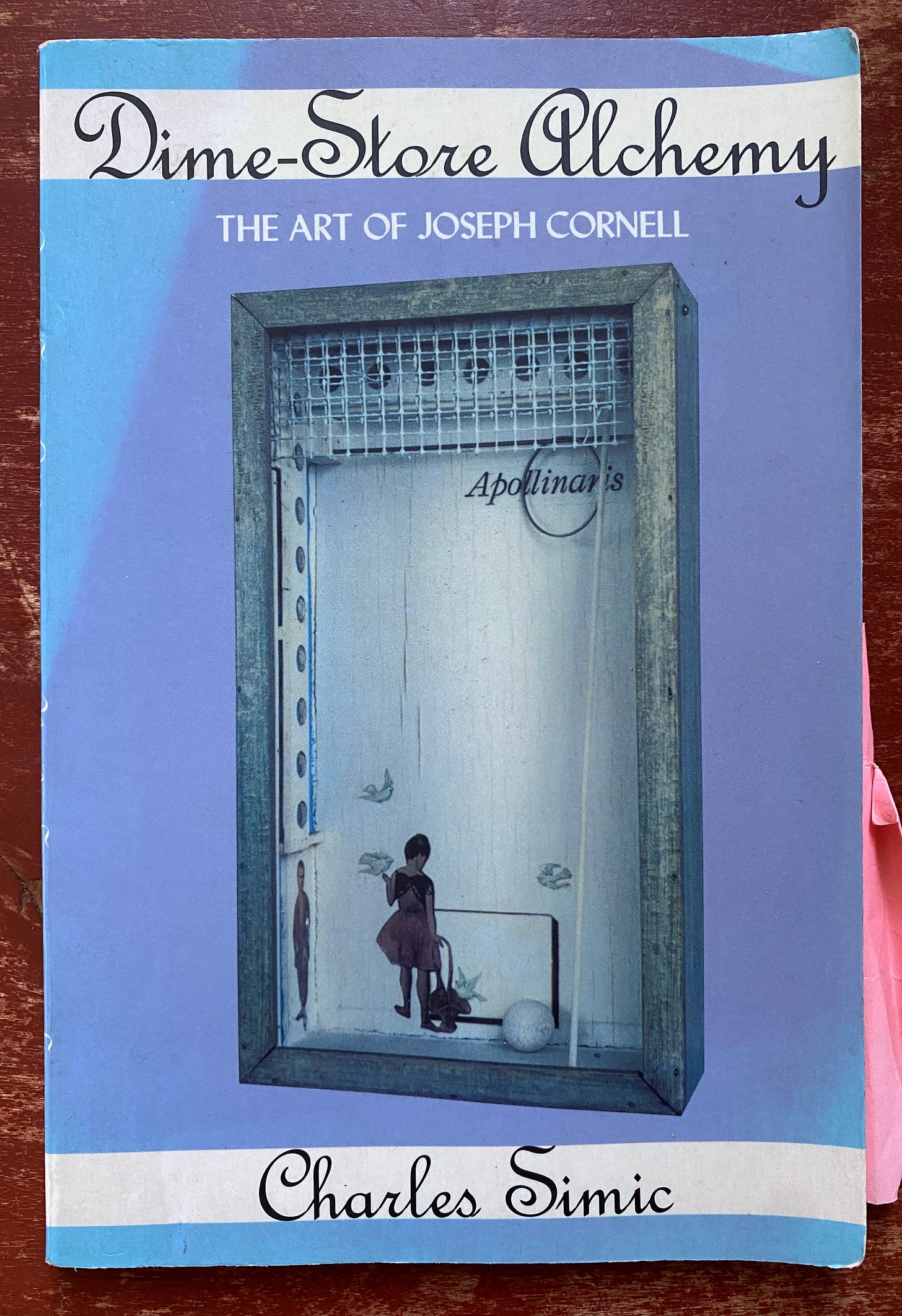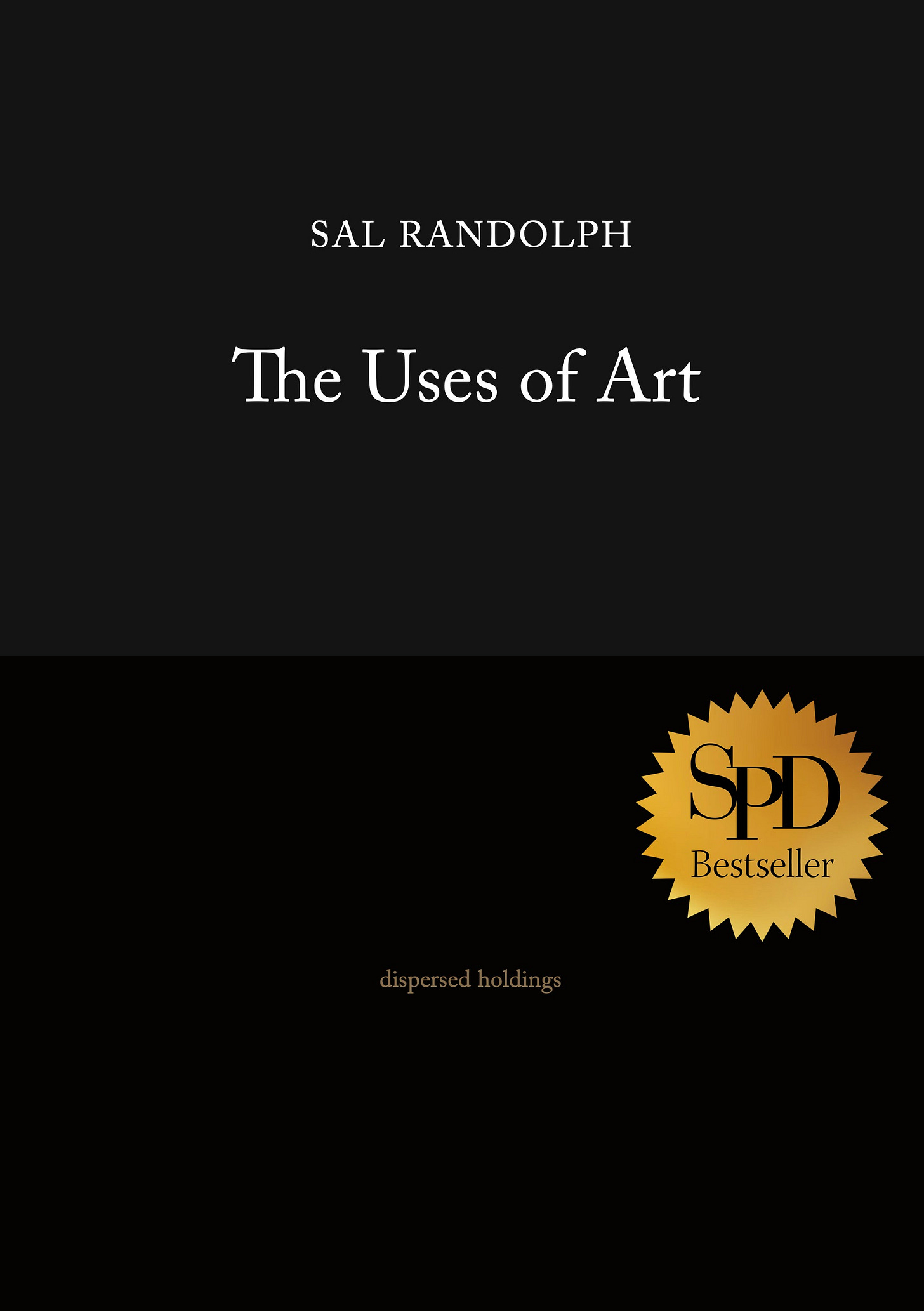
Dear Friends,
This week I take inspiration from Dime-Store Alchemy, poet Charles Simic’s beautiful book on the art of Joseph Cornell. It’s a book I carry around with me, a talisman book, and an essay on my experience of the book is up now on M. E. Rothwell’s wonderful The Books That Made Us.
The way of seeing described here is a mode where observation, dream, memory, and imagination flow freely. Chance juxtapositions gather meaning. Everything speaks to everything else. This way of seeing is fundamental to childhood, to poetry, to making, and to deep engagement with with works of art.
— Sal
Reverie
Here are two excerpts Dime-Store Alchemy that offer us something of Joseph Cornell’s way of seeing. The first is a diary entry of Cornell’s that describes the way he moves through a particular day, and the second is a poetic commentary of Simic’s.
WHAT CORNELL DID ON JANUARY 24, 1947
Shaved and dressed and waved good-bye to Robert on porch (Mother shopping). Waved to Robert from train. So far uneventful but rest of day picked up that kind of richness in a which a revelling in detail becomes such a feast of experience—went all the way in to Penn Station. Just before going under tunnel looked up at freight cars—the word Jane scrawled on a box-car in large letters, red with a touch of pink, then touches of primary colors mingling with a scene of men working on the tracks with a long crane mounted on a car—all over in a flash but evoking a strong feeling—had not remembered anything just like that at that point—but similar varied combinations many times from the elevated viewpoint of the subway before going under at the same point (the puffing locos, omnipresent pigeons, markings on cars in freight yard, etc.) Once in awhile a touch like the above. This enhanced by a touch of spring in the air. Sunny. Took bus (1:30) to 42 & 11 Ave.—feeling of great felicity in large corner cafeteria with aspect of dog-wagon. Griddle cakes, coffee, apple pie a la mode. Walked up 11 Ave to clear up my film at Major Labs where for almost ten years M. Francis Doublier, the pioneer Lumière cameraman, has accomodated me. Went up in freight elevator and got glimpses into different floors not afforded by passenger elevator (out of order) of workers in grimy industrial plants. Remembered with vividness the days of George Boyce and the early movies acquired from him. Took bus crosstown and lingered before appointment at Vogue, 4:00. Found Jerry Lind song sheet, La Sonmambula, and colored feathers in dime store. Boxes got good reception. Up to 59th. St. windfall of Bibliotècque Rose to cover etuis, Souvenirs containing good Gérard de Derval (DeCampo), an original colored Deveria of a standing oriental woman musician—two heroic sized forest prints for owl boxes—unusual feeling of satisfaction and accomplishment, unexpected and more abiding than usual.
THE GAZE WE KNEW AS A CHILD
“People who look for symbolic meaning fail to grasp the inherent poetry and mystery of the images,” writes René Magritte, and I could not agree more. Nevertheless, this requires some clarification. There are really three kinds of images. First, there are those seen with eyes open in the manner of realists in both art and literature. Then there are images we see with eyes closed. Romantic poets, surrealists, expressionists, and everyday dreamers know them. The images Cornell has in his boxes are, however, of the third kind. They partake of both dream and reality, and of something else that doesn’t have a name. They tempt the viewer in two opposite directions. One is to look and admire the elegance and other visual properties of the composition, and the other is to make up stories about what one sees. In Cornell’s art, the eye and the tongue are at cross purposes. Neither one by itself is sufficient. It’s that mingling of the two that makes up the third image.
Exercise: Reverie
This is an exercise for new ways of looking at at a work of art and exploring forms of attention; it could be done in a museum, or a gallery, or any space you want to explore. Use it to discover something you want to spend time with and as a kind of guided meditation for that time. You could also try this with other objects of attention and other kinds of spaces.
Interpret the instructions freely and intuitively.
Walk through an unfamiliar space. This can be the unfamiliar space of a single work of art, or an art space, a library, a city, a trail through the woods.
As you walk, gather images and impressions. These can be words, objects, a certain cast of light, sounds.
Let yourself daydream and free-associate; adopt the gaze of a child.
Remember something vividly.
Allow all of these sensory images, imaginings, and memories to speak to each other and gather meaning.
If you like, make something from what you have gathered, a poem, a drawing, a sculpture, a song.
Share what you discover in the comments.
Dime-Store Alchemy: The Art of Joseph Cornell, by Charles Simic has been re-issued by NYRB Classics.
Further adventures and new ways of seeing can be found in my book, The Uses of Art.
Artist Sal Randolph’s THE USES OF ART is a memoir of transformative encounters with works of art, inviting readers into new methods of looking that are both liberating and emboldening.
Dazzlingly original, ferociously intelligent.
— Michael Cunningham
A joyful, dazzling treasure-box of a book.
— Bonnie Friedman
Here’s a guide, to waking up, over and over again.
— Roshi Pat Enkyo O’Hara








I love trying out these exercises! I happen to read this piece in a public library, which is a perfect place to explore the newness in what appears to be familiar. Thanks so much...
Or a small group of writers each make up a story about the same box and compare.